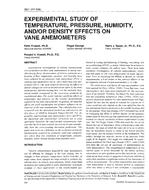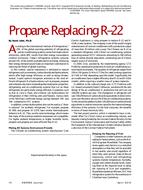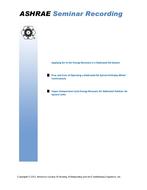This paper defines a whole-building cooling and heating efficiency measure, called the building systems load/energy ratio (LER), as a comprehensive HVAC system efficiency measure. The LER for cooling–or separately, heating–is the ratio of the total cooling/heating loads on the building’s heating and cooling systems to the total energy input provided by all the heating and cooling system componentsto meet the loads. Hence, it is basically a system coefficient of performance (COP) or “efficiency” that includes all of the heating and cooling system energy consumed instead of just the boiler or chiller energy. Specifically, the building systems total load is composed of the envelope load, the load from internal gains, and the ventilation load on the secondary systems. The total energy input includes inputs to chillers, boilers, pumps, and fans on both the air side and water side. Hourly LER values for both heating and cooling are calculated separately when there are both heating and cooling loads in a building during the same hour. The LER may bedefined in terms of the cost of different energy sources, interms of site energy consumption, or in terms of source energy consumption. Two buildings on the Texas A&M University campus that are served by a central utility plant are used as case studies to illustrate the methodology. The annual cooling cost LERs for the two case study buildings are 2.28 and 2.46 (1.54kW/ton and 1.43kW/ton), respectively–about half of the chiller plant’s annual average cooling load/energyratio of 4.6. The annual heating cost LER for these buildingsis 0.043 for one building and 0.46 for the other building, whilethe boiler plant average heating efficiency is 0.79. The siteenergy cooling LER is 19% to 37% lower than the coolingcost LER for the two case study buildings, while the sourceenergy cooling LER is about one-third of the cooling cost LERin both cases. The site energy and source energy heating LER values range up to 28% larger than the corresponding heating cost LERs. The current minimum seasonal energy efficiency ratio (SEER) value for a split-system air-conditioner in Texas is 14, which corresponds to a COP of 4.1. It is noteworthythat to the extent that SEER represents annual performance, the annual cooling cost LER values of the case study buildings are 60%, or less than the minimum COP value for a split system, even for a variable-air-volume (VAV) system with very little reheat.
Citation: 2018 Winter Conference, Chicago, IL, Technical Papers
Product Details
- Published:
- 2018
- Number of Pages:
- 16
- Units of Measure:
- Dual
- File Size:
- 1 file , 810 KB
- Product Code(s):
- D-CH-18-008


